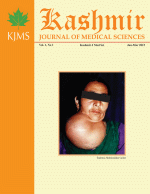MAXIMAL SENSORY BLOCK AND HAEMODYNAMICS AFTER SPINAL ANAESTHESIA IN WOMEN UNDERGOING ELECTIVE CAESAREAN SECTION
Keywords:
Anaesthesia, Caesarean Section, Spinal, Sensory Block, BupivacaineAbstract
Background: Spinal anaesthesia for caesarean section has gained popularity over epidural techniques because of its easy placement and rapid onset. In pregnant women, engorgement of epidural veins from aortocaval compression with displacement of cerebrospinal fluid (CSF) may contribute to unwanted cephalad extensions of the block. The aim of our study was to evaluate the interval of time required for the maximal sensory block along with haemodynamic variations of pulse and blood pressure after spinal anaesthesia among patients undergoing elective caesarean section.
Methods: A prospective study was conducted at the Department of Anaesthesia, Holy Family Hospital, Rawalpindi Medical College, Rawalpindi, Pakistan over a period of 6 months. Spinal anaesthesia was given to 100 participants using 25 G, Quincke needle and 1.8 ml of 0.75% hyperbaric bupivacaine was injected. Patients were positioned supine immediately and 10° head down tilt and wedge was placed under right hip to prevent aorto-caval compression. Block level was assessed every 2 minutes with sensation to touch, pinprick, and cold ice saline for 30 minutes. Procedure was started as the maximal sensory T4 block confirmed.
Results: The maximal sensory block achieved was up to the level of 3rd thoracic site (T3) with a range of T2-T7. The mean time for the block to reach maximal sensory level was 9.2±4.6 minutes. The maximal decrease in pulse, systolic BP and diastolic BP were 15.4±8.7/min, 33.6±11.3 mmHg and 18.2±7.8 mmHg respectively from the baseline.
Conclusions: Injection bupivacaine 0.75%, 1.8 ml given via spinal needle in the subarachnoid space at the level of L3–L4 is sufficient to
provide an adequate T4 sensory block in the desired time.
Downloads
Published
How to Cite
Issue
Section
License

This work is licensed under a Creative Commons Attribution-NonCommercial-NoDerivatives 4.0 International License.






